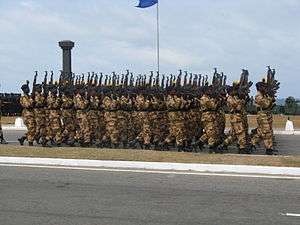Sri Lanka Civil Security Force
| Civil Security Force සිවිල් අාරක්ෂක බලකාය இலங்கை சிவில் பாதுகாப்பு | |
|---|---|
 | |
| Active | January 1, 1986 - Present |
| Country | Sri Lanka |
| Type | Militia |
| Role | Civil Defence |
| Size | 39, 800 |
| Part of | Ministry of Defence |
| Motto(s) | Protect the Nation with Self-Sacrifice |
| Engagements | Sri Lankan Civil War |
| Website |
csd |
| Commanders | |
| Director General | Major General Nirmal Coswatte |
The Sri Lanka Civil Security Force (Sinhala: සිවිල් අාරක්ෂක බලකාය Sivil ārakshaka balakāya; Tamil: இலங்கை சிவில் பாதுகாப்பு) (also known as the Civil Defence Force) is a paramilitary militia tasked to serve as an auxiliary to the Sri Lanka Police. Originally the National Home Guard Service, it is directed by the Civil Security Department. The current Director General of the Civil Security Department is Chandrarathne Pallegama.
The activities relating to the Home Guard Service were established under the Mobilization of Supplementary Force Act No. 40 of 1985, bringing local Home Guard militias under the command of the local police.[1] Service in the Civil Security Force is voluntary, with personnel being deployed in their home towns and villages, originally to protect the local population from attacks by the LTTE. With the establishment of Civil Security Department, the Home Guards were re-designated as the Civil Security Force and came under the purview of the Ministry of Defence.
The CSF is not to be confused with the Sri Lanka National Guard, which is a volunteer reserve regiment of the Sri Lanka Army.
Functions
- To serve as auxiliary to the police and aid in the maintenance of internal security,
- To serve in static defensive duties such as manning checkpoints, guarding low priority buildings or installations, guarding villages etc.,
- To function as an emergency force intended for special tasks directly or indirectly connected with the defense of the country, and
- To help the community in any kind of emergency, such as a natural disaster.
Other, more special duties include:
- Providing security to centers of economic importance,
- Protecting supply routes.
History and establishment

The start of the Sri Lankan civil war saw attacks by the LTTE on "border villages" (villages bordering the edges of the frontlines), causing considerable civilian casualties. Villagers began organizing themselves into Home Guards, wherein local volunteers were initially armed with shotguns by the government, to help defend low priority rural areas that could not be held or protected by the armed forces without compromising the frontlines. The National Home Guard Service was thus established in 1986 by then Minister of National Security Lalith Athulathmudali with a strength of about 5000 personnel, armed with 12 bore shotguns and brown uniforms. No allowances were paid initially, but some rations were issued through co-operative outlets. Subsequent to the takeover by the Police, the volunteers were paid a daily allowance, and provided training at Kumbuka camp, Horana.
In 1988 guardswomen were allowed to volunteer, and 1993 saw the first issue of automatic rifles to the Home Guard. In April 2006 the Home Guard was renamed the Civil Defence Force, followed by the establishment of the Department of Civil Security on 1 January 2007 (through gazette notification No. 1462/20 of 13 September 2006) to oversee it. Numbers employed increased to 41,500 and a month-long military training regime was introduced. Further, two types of uniforms (similar to military uniforms) were issued to guardsmen. Since then, members of the force have been deployed outside their home villages to maintain public security, including within the capital Colombo.
Functions of the Civil Security Department were established to be:
- Taking actions as a supplementary force for aiding and assisting the armed forces and police service, depending on the prevailing security status in the country,
- Taking action to safeguard villages, properties and cities where terrorist threats are present,
- Assisting the police and armed forces to maintain law and order,
- Engaging in security duties on instances of national events and any other important occasions,
- Assisting with disaster mitigation and relief efforts,
- Assisting with social welfare activities,
- Carrying out any special duties specified by the President, line ministries or the government, and
- Operation of a Civil Security Department Headquarters.
In the post-war period, CSD personnel are involved in community service projects, including agriculture, social welfare development, animal husbandry, and construction projects.
Ranks
Training
Training is provided in two stages: basic training is provided by the Sri Lankan Army at various army training centres, usually for 2–4 weeks, while periodical training is carried out by mobile training units in the areas where units are deployed.
Equipment
- Type 56 assault rifle
- FN FAL
- .303 Lee–Enfield
- various shotguns
References
- ↑ "Mobilization And Supplementary Forces Act (No. 40 of 1985)". commonlii.org. Commonwealth Legal Information Institute. Retrieved 3 November 2017.
- 1 2 3 4 "ප්රාථමික අර්ධ ශිල්පීය සේවා ගණය (PL-02-2006A) සඳහා උසස්කිරීම් පරිපාටිය" (PDF). csd.lk. Civil Security Department of Sri Lanka. Retrieved 29 January 2018.